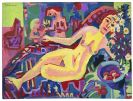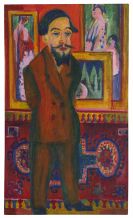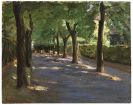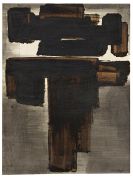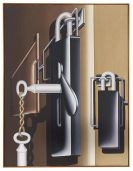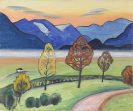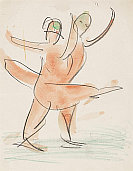
Ernst Thoms
Nienburg
1896 -
Vietzen bei Nienburg
1983
Ernst Thoms grew up in Nienburg on the Weser. After serving a painter's apprenticeship between 1911 and 1914, he had time to study for a few months at the Hanover School for the Decorative and Applied Arts before being conscripted. Ernst Thoms was a prisoner of war in an English internment camp but returned home in November 1919.
He once again spent some months at the Hanover School for the Decorative and Applied Arts in 1920 in the class taught by Burger-Mühlfeld, where he was introduced to Grethe Jürgens and her circle. Ernst Thoms, however, remained for the most part self-taught. His genres of choice were landscapes, still lifes and portraits.
During the galloping inflation of the early 1920s, Ernst Thoms was forced to eke out a living as a house painter but in 1924-25 he also painted advertisements and stage-sets. At that time Schwitters and Vordemberg-Gildewart were also active in Hannover, where their work was highly respected. Whereas the realism of the sort practised by the "New Objectivity Group" was regarded as an anachronism, Ernst Thoms was the only advocate of this style to achieve recognition by the 1920s.
He had his first show in 1926 at the Kestner-Gesellschaft in Hannover and the Provinzialmuseum bought his painting "Dachboden" ["Attic"]. Ernst Thoms subsequently joined the "Deutscher Künstlerbund" and the "Hanover Secession". He showed work at exhibitions in Amsterdam, Stockholm and most larger German cities as well as at the Neumann-Nierendorf Gallery in Berlin, the Hamburg Secession and the Kestner-Gesellschaft in 1928, 1931 and 1932.
Ernst Thoms was awarded Honorable Mention in 1930 by the Prussian Ministry of Culture for his "Bildnis der Mutter" ["Portrait of His Mother"]. Thoms took part in the 1934 Venice Biennale and married Grete Giesemann that same year. In 1937 the National Socialists confiscated the pictures by Ernst Thoms that hung in German museums.
In 1939-40 Thoms was again conscripted. When his studio and his flat were gutted in a bombing raid in 1943, all the pictures of his that were his personal possessions were destroyed. Nevertheless Thoms continued to paint after the war ended. In 1950 he returned to Hanover. The Hanover Kunstverein mounted a retrospective of Ernst Thoms's work on the occasion of his sixtieth birthday.
In 1964 Thoms was decorated with the Grand Service Cross of the Order of Lower Saxony. From 1968 deteriorating eyesight was a handicap for Ernst Thoms in his last years although he continued to paint.
Ernst Thoms died in Vietzen near Nienburg in 1983. His work, which remained close to New Objectivity, has always been appreciated and acclaimed.
Would you like to sell a work by Ernst Thoms?
Infos for seller

